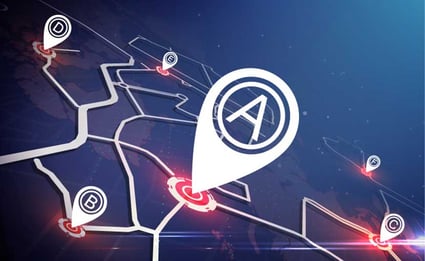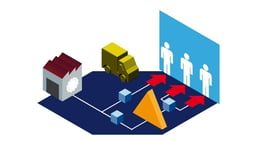The First Step of the Last Mile is the Most Important
Keith LaBotz - March 10, 2022

Customers increasingly judge companies on the delivery experience and supply chains are taking note. Excellent customer experiences result from excellent last-mile logistics, so what’s the key to providing it?
If you guessed transportation, you’re partially correct, but transportation consists of multiple processes, and one, in particular, lays the foundation for last-mile logistics. That’s the key we are after, and it's where all last-mile initiatives should begin.
Understanding what this process is and why it’s key requires knowing why last-mile logistics is a top priority for supply chains. The accelerating sales growth of last-mile delivery solutions shows strong interest, hinting at its importance.
Interesting trend, but the herd is often wrong so let’s examine the last mile and give you something more to go on for your own conclusion.
Why the Last Mile is Important
The last mile poses big problems and opportunities, depending on how your company addresses the transportation process. On a tactical level, split-second decisions in the final approach can ruin weeks of flawless effort or result in a happy customer.
Companies like Amazon recognized the strategic advantage of last-mile logistics from the get-go, building an entire supply chain around it. You can read more about this in my previous post. Regardless of what a company does, customers need to know shipments arrive as expected, and your business needs to count on it happening profitably.
Last Mile Challenges Are Increasing
Delivering the right material, data, and capital to the right place at the right time is increasingly difficult to accomplish at a profit without smart automation. There are several reasons last-mile solutions are a top priority now:
- The last mile, the final stretch connecting your supply chain to the customer’s door, concentrates risks, costs, and opportunities unlike any other area of the supply chain.
- 61% of transportation and logistics organizations rank it as the least efficient supply chain process, accounting for roughly 53% of total transportation costs.
- Costs and risks per mile are higher for vehicles approaching the customer. Expenses will likely increase if inflationary monetary and energy policies do not reverse soon.
- As more companies improve the customer delivery experience and last-mile efficiency, competitive benchmarks will increase, and the gap will widen between innovators and the herd.
Last Mile Solutions Preserve Value
An effective last-mile solution acts as an insurance policy, preserving the collective effort of a value chain preceding a pickup or delivery. Preventing a delivery failure avoids undermining the mission and the tremendous waste of resources preceding a botched delivery.
Last Mile Solutions Promote Sustainability
Supply chain resources involved in facilitating a pickup or delivery are not wasted when scheduled vehicle stops are successful. Last-mile solutions leading to efficient collaboration, less time idling in heavy traffic, and greater fuel economy reduce greenhouse emissions and consumption of natural resources.
Last Mile Solutions Add More Value
The final mile is more than just transportation; it involves virtual and physical interactions with the customers, creating a personal experience. This leaves an impression more compelling than the slickest sales and marketing campaign.
Process improvements that end up making life easier for customers are remembered and it has a lot to do with streamlining the fulfillment process. Digitalization and lean logistics play a significant role. Here are a few areas companies are concentrating on for last-mile solutions:
- Transparency Real-time tracking, the ability to manage delivery arrangements, and easy online returns have set expectations for greater transparency. Buyers no longer distinguish the delivery experience at home delivery from business deliveries while at the office or factory. Companies that evolve with changing customer expectations prosper and transparency encourage customer collaboration that leads to customer-focused innovation.
- Big Data Analytics Last-mile delivery optimization is a continuous operational state - it is not a report created before sending trucks on their way. Obtaining the big picture leaves nothing to chance. Transportation providers like DHL and FedEx use hyper-local weather forecasts, global positioning systems (GPS), and traffic data to ensure vehicles navigate disruptions without incident. Adjusting plans with changing conditions increases efficiency and reduces waiting times, fuel consumption, and greenhouse emissions.
- Warehouse Automation Smart WMS systems optimize and automate workflow. Combined with robots and intelligent material handling systems, things are moving things in and out of the warehouse and trucks faster than ever before.
- Telematics GPS mobile devices integrate vehicle operations with big data analytics, enabling real-time monitoring and reporting of drivers and vehicles. Delivery status updates, real-time order tracking, updated ETAs, and ensuring compliance with driver time regulation are seamlessly managed.
- Autonomous Ground Vehicles (AGVs) Autonomous forklifts and yard operations will continue replacing traditional processes. Autonomous trucks on the open road should eventually appear. Even if robotic delivery vehicles become the norm, personal interaction with a driver will likely remain imperative for many niches.
Last Mile Solutions Depend on Reliable Vehicle Routing
Last-mile solutions depend on one crucial function - a reliable routing process that ensures trucks arrive on time as scheduled. If vehicle routing fails and schedules are not met, the primary mission fails and any other solutions supporting the mission become irrelevant. When the mission fails, supporting technologies are transformed into unproductive assets:
- Transparency showcases failure.
- Impressive AGVs become robotic idiots.
- Telemetrics, analytics, and state-of-the-art warehouses - what’s the point if delivery vehicles cannot finish the job?
Staying on schedule with pickups and delivery fulfills the most basic requirement of the last-mile mission. This can only happen with certainty if a dynamic vehicle routing process is used.
Dynamic Vehicle Routing is the Key
A dynamic vehicle routing process like flexis ProfiTour can guide each vehicle to its destination to meet customer expectations. Adjusting delivery plans enroute with changing traffic and weather conditions ensures the best possible outcome that meets all objectives:
- On-time pickup and delivery.
- Reducing greenhouse gas emissions and carbon credits.
- Minimizing total delivery cost by economizing fuel consumption and driver time.
- Maximizing driver productivity thru minimizing wait times and avoiding traffic congestion.
- Compliance with driver time regulations to avoid costly fines for driver and company.
With a reliable delivery plan, last-mile solutions can be implemented to enhance functionality to improve the customer experience.
Conclusion
A dynamic vehicle routing process is the starting point for last-mile logistics. Process improvements that begin with a reliable transportation process connecting your company with customers, lays a solid foundation for last-mile solutions.
Click below for more information on ProfiTour
LATEST POSTS
- Understand Circular Economy in The Manufacturing Industry
- How Can Industry 4.0 IT Integration Be Achieved Smoothly?
- The Significance of Order Sequencing in Discrete Manufacturing
- How to improve your Supply Chain Management: The Power of Control Towers
- Optimizing Human Resource Scheduling in Manufacturing: A Technological Approach



